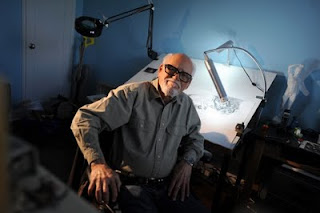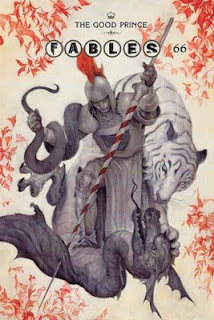Gene Colan, who died last Thursday at the age of 84, was the first comics artist I noticed.
I’ve blogged before about how Daredevil was an inspiration to me as a kid, how the adventures of the sightless superhero helped me deal with my own deteriorating eyesight and fears of going blind. And while I’ve always been more into the words than the pictures in comics, Gene Colan was the exception to that rule.
Those first few comics I bought from the used bookseller mostly dated from the 1970s, and I read every word on every page. I read the copyright notices. I read the ads. And I read the letter columns, also known as lettercols. In one early issue, sandwiched between arguments about whether it was appropriate to have Uri Geller guest-star in a Marvel comic book, was a letter asking the editorial staff to bring Gene Colan back on as the book’s regular artist. The letter writer, whose name has vanished from my memory, praised Colan at length, going on about his distinctive, masterful pencils.
 Later, when I found a few Daredevil issues with Gene Colan listed as their artist, I studied his work closely to see what the fuss was about. I noted the way his characters often seemed to emerge from deep pools of shadow. Darkness in Gene Colan’s art was an independent force, alive and vibrant. Where other artists used token shadows to give their pictures a touch of dimensionality, Colan built worlds with it, using shadows to create rich, complex settings and characters. His art looked like nothing else anyone was doing, before or since. A few years after he drew those iconic Daredevil adventures, someone coined a term for what Colan did—“painting with pencil.”
Later, when I found a few Daredevil issues with Gene Colan listed as their artist, I studied his work closely to see what the fuss was about. I noted the way his characters often seemed to emerge from deep pools of shadow. Darkness in Gene Colan’s art was an independent force, alive and vibrant. Where other artists used token shadows to give their pictures a touch of dimensionality, Colan built worlds with it, using shadows to create rich, complex settings and characters. His art looked like nothing else anyone was doing, before or since. A few years after he drew those iconic Daredevil adventures, someone coined a term for what Colan did—“painting with pencil.” Colan started in comics in the 1940s and drew just about every hero of note at some point. He was best-known for his runs on Iron Man, Daredevil and Tomb of Dracula (and Howard the Duck—yes, you read that right, and the comics were good). He co-created Blade the Vampire Hunter—the guy Wesley Snipes played in the movies. He also co-created the Falcon, a longtime sidekick to Captain America who was the first African-American superhero in mainstream comics (the Black Panther came first, but he was African) and the first black superhero not to have the word “Black” in his name. It was Colan’s idea to make the Falcon black—not for political reasons, but because he enjoyed drawing African-American facial features and found them interesting and beautiful. That was the way he worked, when he was allowed—he drew the things he found interesting, and it made his stories richer.
I learned to draw—as much as I can draw—by copying Gene Colan. My pencils never ended up looking much like his, but I learned a lot about anatomy and a fair bit about the use of light and shadow. When I was stuck on a story, I would often pull out a sketchbook and try to work out a character’s face or costume, sketching my feelings about the story into the shadows in their hair or the cast of a mouth. Somewhere I think I still have one of the sheets where I carefully copied—never traced—every image of Daredevil from one of his comics. I wasn’t an artist, but it taught me to think.
To this day, when I plan scenes in my stories, I think about light and shadow and how it falls on and around my players. When a high-school drama teacher assigned me to block the balcony scene from Romeo and Juliet and keep the lovers apart without a balcony, I placed Juliet next to a candle and forced Romeo to stand outside the circle of its light lest he be discovered. The big fight scene in Masks is blocked heavily around light and darkness, when characters can be seen and when they must materialize out of solid black. In my head, they look like Gene Colan illustrations, emerging out of the shadows to do amazing things.
I met Gene Colan exactly once, at Comic-Con in 2009. I found out at the last minute that he would be attending, and was so flustered that I couldn’t even find any of my Daredevil comics for him to sign—and many of them were so old and fragile that I couldn’t bear to risk them on the train journey. Instead, I grabbed the most recent thing he’d drawn, a 2009 stand-alone issue of Captain America about the hero and his sidekick Bucky fighting vampires during World War II. (Characteristically, writer Ed Brubaker said the story came out of Colan telling him he wanted to draw “World War II, darkness, and rain.”) It was the issue for which he and Brubaker would later win an Eisner Award, comics’ equivalent of the Oscar, for Best Single Issue.
I was with a friend, and told her that we could do anything she liked, see anything that interested her, at the convention—as long as I got to meet Gene Colan. Shortly after lunch, I finally figured out where his table in the artists’ alley was, and approached it with trembling hands, trying not to bend or warp the comic lest I give the impression that I did not respect the gentleman’s work.
He wasn’t there.
A woman was—I believe it was his wife, Adrienne. I explained my situation and how much Gene Colan’s art meant to me, and she smiled politely and offered to sell me an original print that he’d signed earlier. It was a bit north of my budget, but I gladly bought it, well aware that many Golden and Silver Age artists use commissions and con sales to pay their bills because they retain few rights to their earlier work. As far as I was concerned, Colan had more than earned my money. I guess my earnestness showed, because Mrs. Colan suggested I come back at a certain time, when her husband would likely have returned. She said he’d be particularly happy to meet a young woman who appreciated his art—he had few female fans. I gladly agreed, wheedled my friend into letting me come back, and wandered off for a while to kill time.
When I did come back, he was waiting there at the table, a small, slightly hunched man with a white beard and a red baseball cap with the Daredevil insignia on it (which made me doubly happy, of course). He visibly brightened up when Mrs. Colan pointed me out as “the young lady I mentioned.” I gushed incoherently about learning to draw by copying his art, and for some reason made a big deal of never tracing it. He approved, smiled, and said encouraging things. He wore amazingly thick glasses and nearly touched his nose to the cover of my comic when he signed it; the artist who had taught me not to fear darkness was almost blind himself now. I didn’t have the heart to tell him I was really more of a writer than an artist, because I didn’t have a clear way to say what his art had meant to me as a writer. I got so nervous that I completely forgot to tell him I was wearing a T-shirt with my own drawing of Rae Masterson on it (although maybe that was for the best—it really wasn’t a very good drawing, and the colors on the T-shirt had printed strangely).
My friend suggested I take a picture with him, since I was so excited, and I loudly cursed the fact that I’d forgotten my camera at home. My friend gently pointed out that we both had camera phones. I turned bright pink. We hastily arranged a photograph, and Gentleman Gene gamely doffed his Daredevil cap and smiled in the direction of a device he almost certainly couldn’t see. We took the photo, and I thanked him profusely, not wanting to trespass on his time any more than I had to, and beat a hasty retreat. As we walked away, at about 3:00 in the afternoon on my one day at Comic-Con, I turned to my friend and said, “Okay, we can go home now. My day is complete.”
I’ve met movie stars. I’ve met congressmen. I’ve met a couple of my favorite authors, and hope to meet more. I never geeked out over any of them as much as I geeked out over meeting Gene Colan.
He deserved it.
Adrienne Colan died about a year ago. Gene Colan reportedly continued to work on commissions and other artwork up until about a month back. He is survived by his children and legions of fans.
His friend and biographer Clifford Meth, in accordance with Colan’s wishes, has set up the Gene Colan Scholarship at the Joe Kubert School. In lieu of flowers, Meth has requested donations to the scholarship fund, made out to “Joe Kubert School” and sent to:
Gene Colan Scholarship
c/o Clifford Meth
179-9 Rt. 46 West
Rockaway, NJ 07866
c/o Clifford Meth
179-9 Rt. 46 West
Rockaway, NJ 07866
I’ll leave you guys with a note from Mr. Colan, supplied by Greg Hatcher via Clifford Meth:
Rest in peace, Gentleman Gene.





















